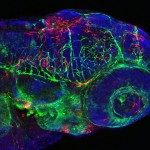Link to Pubmed [PMID] – 23824820
J. Virol. 2013 Sep;87(18):10025-36
ISG15, a 15-kDa interferon-induced protein that participates in antiviral defenses of mammals, is highly conserved among vertebrates. In fish, as in mammals, viral infection and interferon treatment induce isg15 expression. The two ubiquitin-like domains of ISG15 and the presence of a consensus LRLRGG sequence in the C-terminal region, which is required for the covalent conjugation to a substrate protein, are also conserved in fish. Our data demonstrate that overexpression of zebrafish ISG15 (zf-ISG15) in EPC cells is sufficient to inhibit viral infection by RNA viruses belonging to the genera Novirhabdovirus and Birnavirus and by DNA viruses of the genus Iridovirus. In coexpression experiments with IHNV proteins, we demonstrate specific ISGylation of phosphoprotein and nonvirion protein. Mutation of the glycine residues in the consensus LRLRGG motif abolishes zf-ISG15 conjugation to these proteins and the cellular protection against viral infection, thus connecting ISGylation and ISG15-dependent viral restriction. Additionally, zf-ISG15 overexpression triggers induction of the rig-I and viperin genes as well as, to a lesser extent, the IFN gene. Overall, our data demonstrate the antiviral effect of a fish ISG15 protein, revealing the conservation among vertebrates of an ISGylation mechanism likely directed against viruses. Furthermore, our findings indicate that zf-ISG15 affects the IFN system at several levels, and its study shall shed further light on the evolution of the complex regulation of the innate antiviral response in vertebrate cells.


